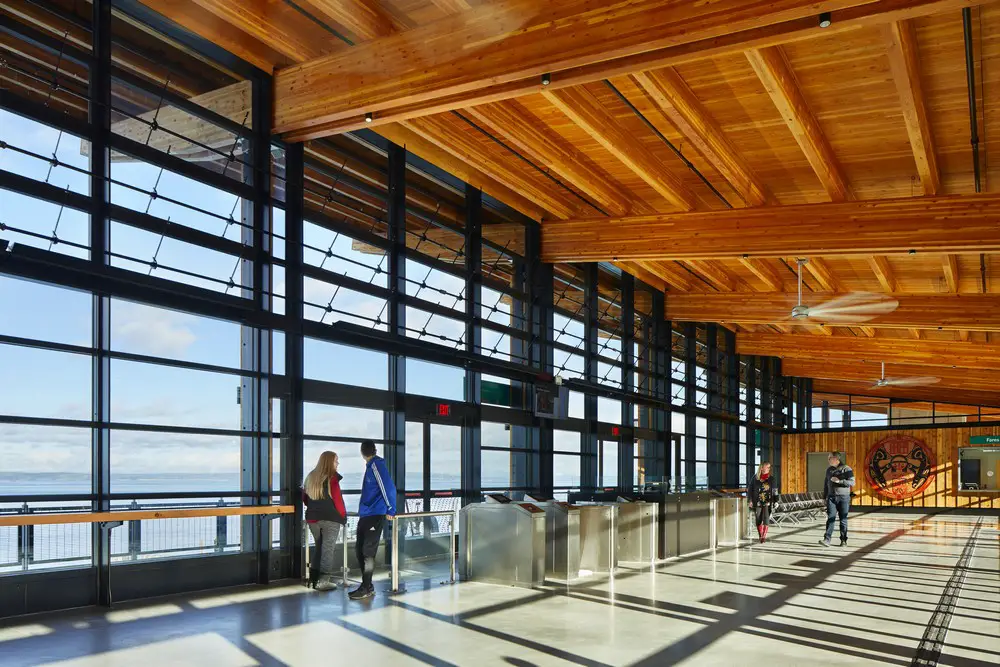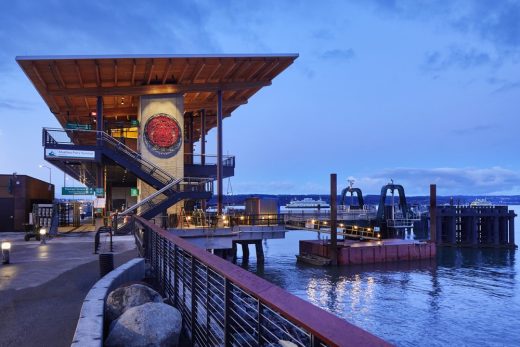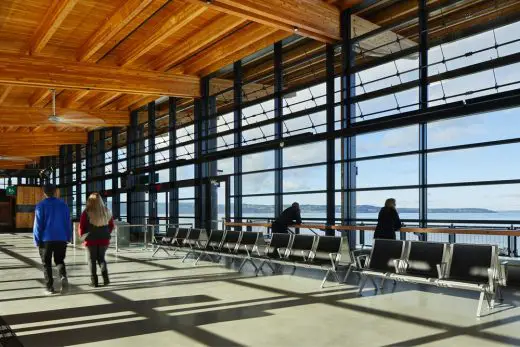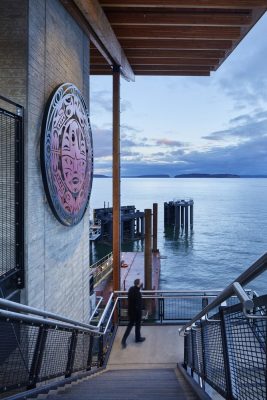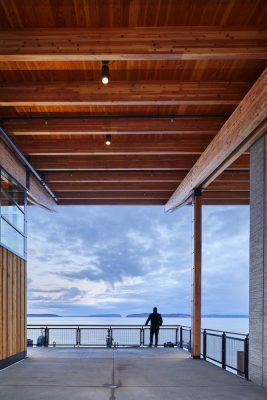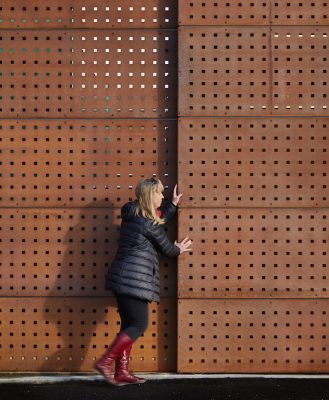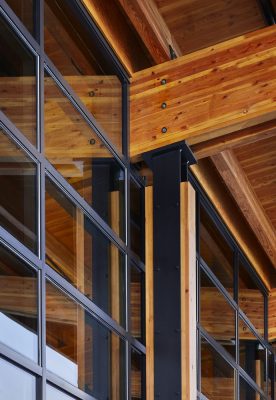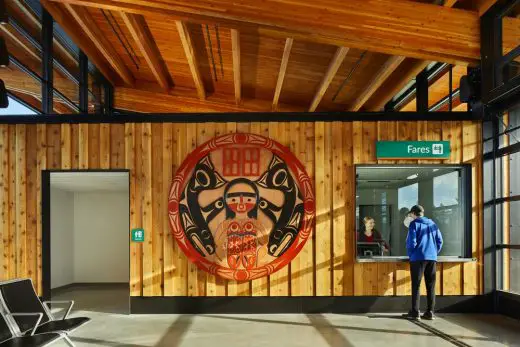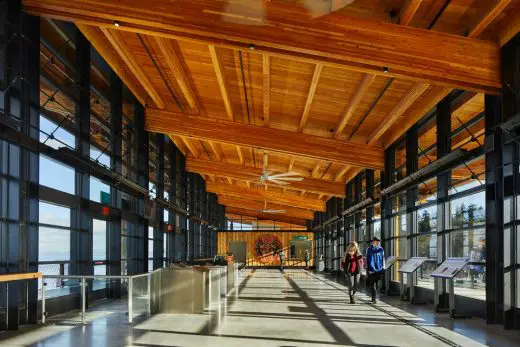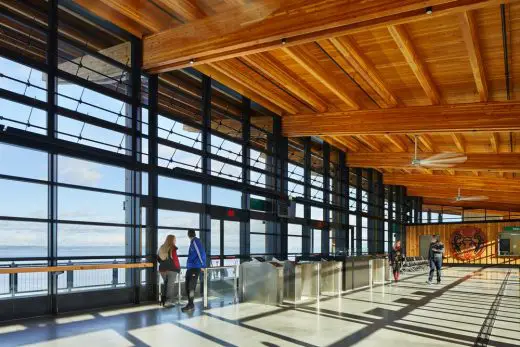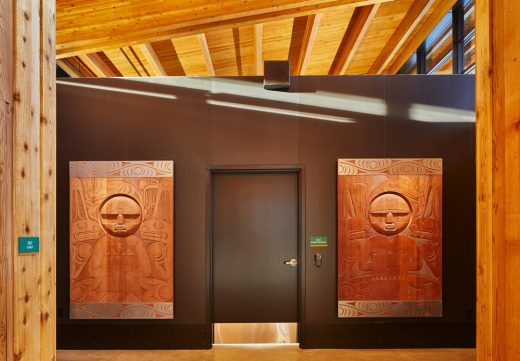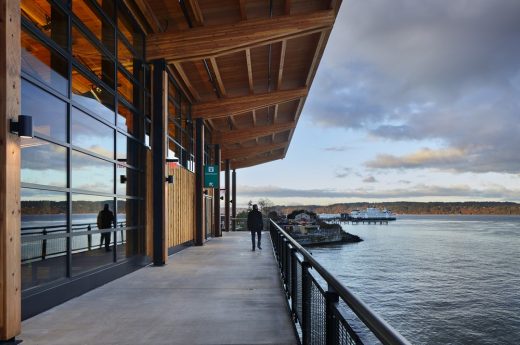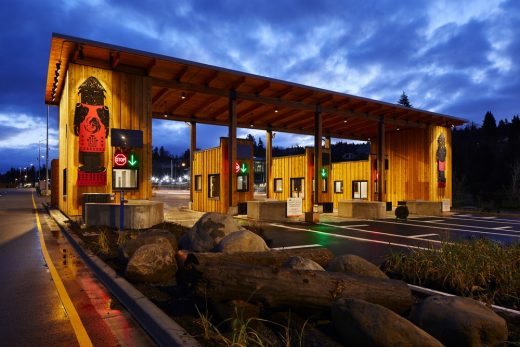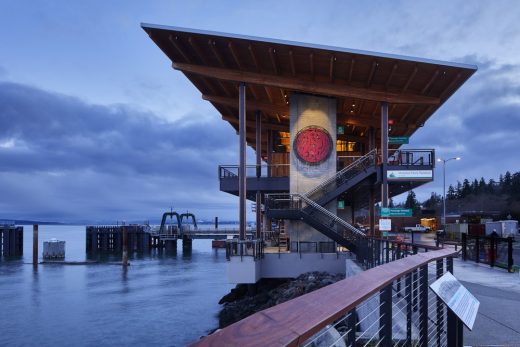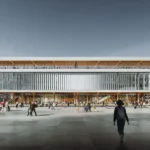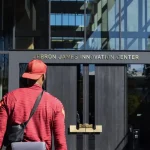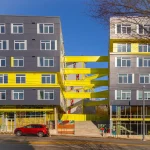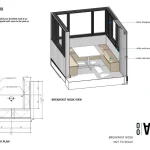Mukilteo Multimodal Ferry Terminal, Washington Commercial Building, Architecture Development Photos
Mukilteo Multimodal Ferry Terminal in Washington
Jan 7, 2021
Design: LMN Architects
Location: Washington, USA
Photos by Benjamin Benschneider
Mukilteo Multimodal Ferry Terminal
LMN Architects is pleased to celebrate the opening of the Mukilteo Multimodal Ferry Terminal in Mukilteo, Washington. With input from local tribes, the two-story terminal building, designed in partnership with KPFF Consulting Engineers, replaces the existing terminal built in 1957 and adheres to contemporary environmental and building standards.
The Mukilteo-Clinton ferry route moves more than two million vehicles and nearly four million riders annually in conjunction with State Route 525, the major transportation corridor connecting Whidbey Island to the Seattle-Everett metropolitan area. With proximity to commuter trains via Sound Transit’s Mukilteo Sounder Station, the new two-story terminal building’s walk-on ridership is expected to increase more than 100 percent over the next 20 years during peak commute times. The new terminal provides more space for vehicle holding and separates pedestrian and vehicle boarding with an overhead walkway for safer, more efficient loading, especially for people with disabilities.
Charlie Torres, Mukilteo Design Project Manager at WSF, comments: “We listened intently and realized our project had to tell a story, one that had been partially hidden from the general public for years and covered under a Cold War fueling tank farm and a pioneer lumbermill before that. The group of designers asked to bring the project together embraced the goal of designing a new ferry terminal that honored and respected the history and values of the Coast Salish people. While only a transportation facility, it owes a debt to the generations of people who occupied this beautiful piece of land along the Salish Sea thousands of years before our time. The project is light on the earth and wrapped in cedar.”
Howard Fitzpatrick, Principal, LMN Architects, comments: “The Mukilteo Multimodal Ferry Terminal is the result of an intensive collaboration between the design, engineering, and contracting teams. But it would not have been possible without the inspiration and sense of mission that the team drew from our tribal partners. The historic significance of the site to the tribes, combined with its incredible natural beauty, inspired the team to produce a project that is imbued with a deep sense of history, while at the same time recognizing the vitality and forward-looking orientation of the area’s original inhabitants.”
The building’s longhouse form, derived through a close collaboration with numerous Coast Salish tribes, enriches the passenger experience, streamlining circulation and managing large patron flows with intuitive wayfinding. Vertical transportation cores with elevators and stairs at each end of the structure lead to a linear promenade at the upper level, from which entries to the ticketing and waiting area are visible.
Phillip Narte, WSF Tribal Liaison, comments: “The Ferry Terminal has been the most challenging project I have been involved in due in part to the collaboration with 11 tribal governments, and the associated cultural and historical issues. I believe the project will become a model for how local, state, and tribal governments can work together. The Mukilteo Multimodal Ferry Terminal is the most rewarding and satisfying project that I will ever work on.”
The waiting room is a daylight-filled space with views to land and sea that help orient ferry riders. Tribal cultural motifs created by local, Native American artists James Madison and Joe Gobin are displayed throughout the building, creating a welcoming atmosphere of regional belonging. In conjunction with the terminal, a new waterfront promenade connects a path from downtown Mukilteo, through the terminal and on to the beach, creating an elevated pathway for public use.
Andrew Bennett, Principal, KPFF Consulting Engineers, comments: “The Mukilteo Multimodal Ferry Terminal has been an amazing opportunity to contribute to our regional transportation system. It was an exceptionally complicated project and KPFF was fortunate to have visionaries like LMN on our team. We were able to work with literally dozens of stakeholders, firms, and government agencies to deliver this project. Everyone can be proud of what we’ve accomplished, and we hope this terminal continues to be a valuable public asset for years to come.”
LMN Architects worked closely with the Coast Salish tribes, whose traditional fishing rights encompass the area’s coastal waters, to incorporate environmental stewardship into the overall concept. The project’s strong sustainability ambitions started with repurposing the brownfield site, which previously housed a U.S. Air Force Cold War fuel depot and pier. Removing the pier eliminated approximately 10 percent of the Puget Sound’s remaining toxic creosote piles. The structural expression combines advanced energy and water conservation, and the longhouse-style shed roof allows for a full array of photovoltaic panels, meaning the facility can return energy to the grid.
The roof canopy is made from cross-laminated timber, sustainably harvested and locally sourced. Heating and cooling the concrete-slab main floor with electric heat pumps efficiently provides interior comfort year-round. A rack-and-pinion window system automatically opens and closes in response to changing conditions, optimizing airflow and comfort. The vehicle holding area features pervious concrete that collects stormwater and filters it through layers of sand before it enters the Possession Sound. Other advanced stormwater treatment systems are used throughout the terminal site.
Howard Fitzpatrick, Principal, LMN Architects, comments: “The design team took the responsibility of building on such a historically significant and sacred site very seriously. While it is impossible to construct a modern facility without impacting the site, our goal was to minimize those impacts, to work with the sun, rain, wind and views that have always defined this coastline to make a building that respects both its site and the culture that has occupied it for thousands of years.”
The Mukilteo Multimodal Ferry Terminal provides a flexible asset for the community while creating a major new transportation hub that alleviates congestion and provides a new connection to public transit. The new terminal improves numerous shortcomings of the existing 63-year old facility while looking to the future with a sustainable approach serving the Pacific Northwest’s rapidly evolving transportation needs.
Walt Niehoff, Partner, LMN Architects, comments: “When we began the design, we were conscious of the transportation and infrastructure needs, but more importantly the rich history of the project and site. LMN and our team of consultants set out to create a welcoming civic space and a terminal for the new century. In addition to providing much-needed infrastructure improvements for the Mukilteo-Clinton route, the building celebrates the nature around the site, meets modern accessibility requirements, and improves both passenger safety and circulation. The Mukilteo Multimodal Ferry Terminal is the first new ferry terminal built in 40 years in the state of Washington, and we are extremely proud to be a part of this effort to help improve public infrastructure in the Pacific Northwest.”
The new terminal officially opened at 5:50 p.m. on December 29, upon arrival of the 5:35 p.m. departure out of Clinton. That sailing marked the end of an 18-hour closure of the route to move floating marine structures from the old terminal to the new one. Because of COVID-19 restrictions on large gatherings, there was no grand opening ceremony.
LMN Architects is recipient of the 2016 AIA National Architecture Firm Award and is widely recognized for its design of projects that support smart, sustainable cities. The firm has successfully completed more than 700 projects across North America, including the double LEED Platinum Vancouver Convention Centre West in Vancouver, Canada; Cleveland Convention Center & Civic Core in Cleveland, Ohio; Tobin Center for the Performing Arts in San Antonio, Texas; and the Voxman Music Building at the University of Iowa in Iowa City, Iowa. The firm’s ongoing dedication to communities at all scales is underscored by its design approach, creating environments that elevate the social experience.
Mukilteo Multimodal Ferry Terminal, Washington – Building Information
Design: LMN Architects
Location: 910 1st Street, Mukilteo, Washington
Client: Washington State Ferries
Design Years: 2014-2017
Construction Years: 2019-2020
Major Building Materials: Concrete, steel, heavy timber and CLT
Program: Multi-modal Ferry Terminal with Maintenance Building and Toll Plaza
Site Area:
401,112 SFT (37,264.5 sqm)
Floor Area:
Terminal: 5,865 SFT (545 sqm)
Maintenance Building: 4,193 SFT (389.5 sqm)
Toll Plaza: 828 SFT (77 sqm).
Building Height: 47 FT. (14 m.)
Number of Floors: 2
Cost of Construction: $187 million
Project Team:
Clay Anderson
David Backs
Greg Bishop, AIA
Elizabeth Correa, AIA
Aubrey Davidson, AIA
Matthew Fisher, AIA
Howard Fitzpatrick, AIA
Cody Gabaldon
Apoorv Goyal
Mette Greenshields, AIA
Chelsea Holman
Euiseok Jeong, AIA
Gustavo Lopez, AIA
Graham Moore, Associate AIA
Lori Naig, IIDA
Walt Niehoff, AIA
Christopher Patterson, AIA
John Petterson, AIA
Bennett Sapin, AIA
Tyler Schaffer, AIA
Todd Schwisow, AIA
Kathy Stallings, AIA
John Woloszyn, AIA
Rushyan Yen, AIA
Prime Consultant; Project Manager, Structural and Civil Engineer: KPFF Consulting Engineers
General Contractor: IMCO General Construction
Landscape Architect: HBB Landscape Architecture
Lighting Design: Dark Light Design
Mechanical/Plumbing Engineer: FSi Consulting Engineers
Electrical Engineer: Jacobs Engineering Group
Communications: Ergosync Engineering
Vertical Transportation: The Greenbusch Group, Inc
Geotechnical Engineer: Hart Crowser
Signage Design: Ilium
Security Design: Washington State Ferries
Photography: Benjamin Benschneider
Mukilteo Multimodal Ferry Terminal, Washington images / information received 070819
Location: Seattle, Washington, USA
Ferry Terminal Building Designs
Ferry Terminal Architecture – selection
Yeoui-Naru Ferry Terminal, Seoul, South Korea
Design: Sasaki Architecture
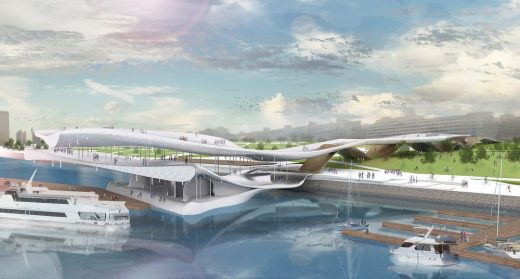
image : Ryuichi Sasaki / Sasaki Architecture
Seoul Yeoui-naru Ferry Terminal
The Meridian line Akashi Ferry Terminal, Japan
Design: K.Associates
Akashi Ferry Terminal Building
Washington Architecture
Seattle Architecture Designs – chronological list
Architects: Bohlin Cywinski Jackson
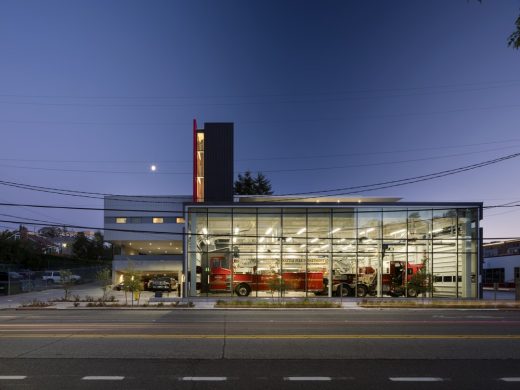
photography : Nic Lehoux
Seattle Fire Station 32
Design: LMN Architects
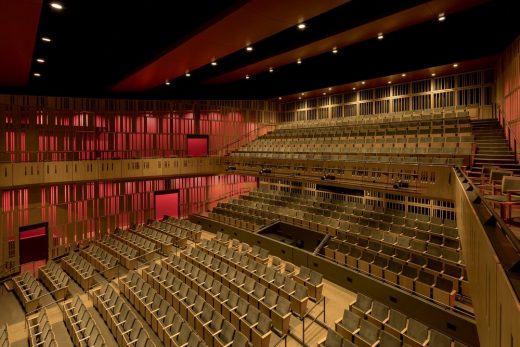
photo : Jeremy Bittermann
Federal Way PAEC Seattle Building
Design: SkB Architects
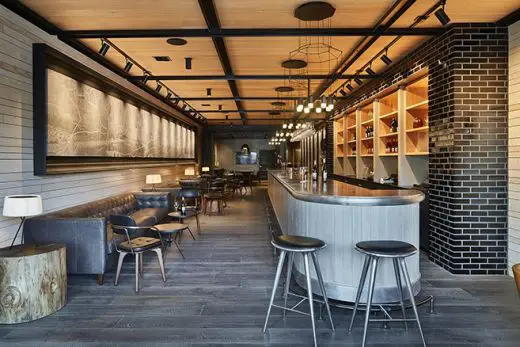
photo : Benjamin Benschneider
Rocky Pond Winery Tasting Room in Chelan, Washington
US Architecture Designs – chronological list
Seattle Buildings – Selection
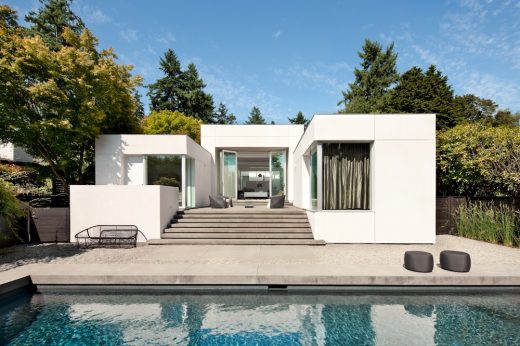
photo : Lara Swimmer
Washington house by SkB Architects
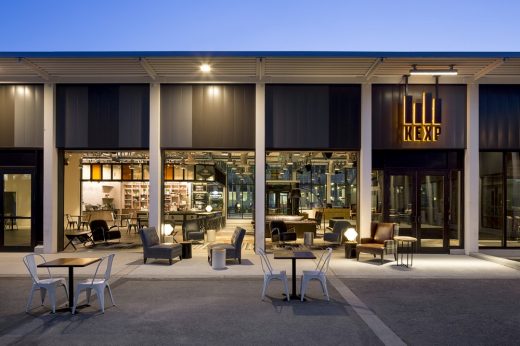
photo : Jeremy Bittermann
Washington building by SkB Architects
Comments / photos for the Mukilteo Multimodal Ferry Terminal, Washington design by LMN Architects page welcome

